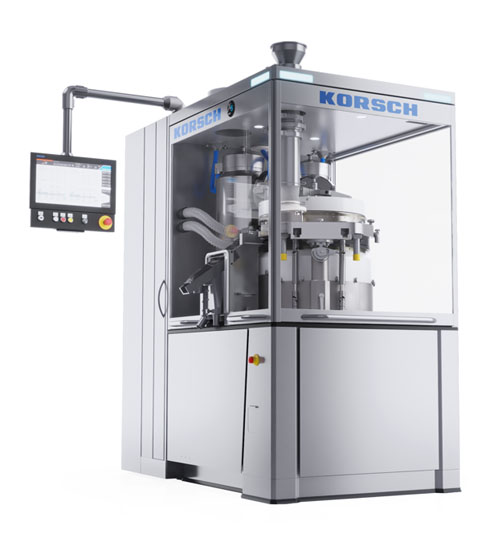Sampling losses occur based on sample size and frequency. Certain advanced presses offer the capability to sample on demand from the HMI which, based on press speed, and will provide a sample of the appropriate size with minimal losses.
Implementing an automated tester for tablet weight, thickness and hardness measurements can automate the sampling process but is unlikely to have any material impact on the magnitude of sampling losses, which are typically very minor.
Batch end scrap: Most advanced presses have a low material level sensor that will stop the machine when the material is almost empty; typically, some material remains in the feed pipe above the feeder.
Depending on the volume of the feeder and the geometry of the feed pipe, some machines offer the ability to override the low material level sensor and run the press under automatic control, producing an incremental quantity of good tablets for as long as the remaining material quantity will support.
In this case, it is the low average compression force alarm that will eventually stop the machine before any reject tablets are produced. For exceedingly small tablets, the incremental quantity of good product produced after the initial low-level alarm can be considerable, adding favourably to overall production yield.
Increasing production uptime
To provide the basis for uptime improvement, it is first necessary to understand the sources of downtime. Most advanced production control systems are equipped with electronic audit trails that track both machine adjustments (event log) and machine diagnostics (alarm log).

An analysis of the alarm log will permit an assessment of any faults that cause the machine to stop, such as punch tightness or the violation of press force limits. Analysing the frequency of these faults offers an opportunity to execute a remediation plan.
For example, frequent machine stops owing to punch tightness may be resolved by increasing lubrication to the upper or lower punches — a simple adjustment made via HMI.
A review of machine alarms can be complemented by an understanding of what adjustments are being made to the machine by the operator during the batch, which is generally captured in the event log.
This provides a time-stamped record of all machine adjustments and includes the operator of record and before/after values for each parameter. In some cases, incorrect adjustments might be occurring that make the process unstable — or that result in faults causing machine stoppage.
When reviewed together, the alarm and event logs can provide insight into what’s happening — at all times — and can identify training deficiencies and remedial actions that have a dramatic impact on overall efficiency.
Once the batch is finished, there is a major emphasis on changeover time. First, the cleaning and changeover requirements must be carefully defined. For example, producing the same product at varying strengths may require a different procedural approach than switching to a completely different product and active material.
In general, the changeover sequence for a tablet press includes
- the removal of all product contact parts
- the removal of the press tooling
- the cleaning of the press and related peripherals
- the installation of new press tools and clean product contact parts.
For some machines, this process can take 8 hours or longer; however, there are several practical ways to reduce this time.
First, the use of uniform change procedure, and a cart specifically designed to house the product contact parts, can ensure a streamlined and consistent procedure to remove the parts in the proper sequence and place them in a repeatable position.
The procedure is then reversed when installing the clean product contact parts back into the press, complete with a regimented standard operating procedure (SOP), sequence and on-cart part position.
Some companies employ the use of a second set of product contact parts, which is cleaned offline and available immediately when the next batch is finished. This simple step can significantly reduce overall change times.
Further, the manual removal and installation of press tools in a turret mounted in the press can be eliminated with the use of an additional turret strategy.
Not only can the turret for the next product be tooled offline (while the press is in operation), the turret configuration (EU/TSM D, B, BB, BBS) can be adapted to the tablet size to maximise production output.
Leveraging an additional turret strategy in combination with a second set of product contact parts and a regimented, streamlined change procedure can reduce overall changeover times by 50% or more, and condense the process to less than 3–4 hours.
And time, of course, is product: more efficient changeovers have an immediate and substantial impact on overall equipment efficiency.
Strategies for semi-attended operation
Although leveraging the latest in tablet press automation can certainly present opportunities for improved operational efficiency, this back-to-basics approach should be considered as a first course of action.
Automation strategies can support a plan to move to semi-attended operation, whereby a single operator can monitor and operate a number of tablet presses concurrently.
First, most advanced control systems permit a configuration wherein a second HMI may be mounted outside the compression suite, eliminating the need for operators to always be present in the room.

It is certainly possible to populate a single HMI with a control system overview of multiple machines. This allows the operator to monitor the process remotely on one or multiple machines from outside the compression suite.
Most high-speed tablet compression suites utilise a post hoist, mezzanine or feeding from a second floor and there is no manual scooping of material into a product hopper. This means that material is fed consistently to the tablet press and no operator intervention is required, at least until a drum or IBC change is required.
In many applications, a full-time operator presence is required in the room to monitor tablet collection and manually replace full containers to permit the press to run continuously.
Most modern deduster and metal check combination units offer a lifting height and a tablet diverter that supports the automated feeding of a large IBC or multiple, smaller containers based on a preset tablet count.
Based on the container size, these systems can eliminate the need for the operator to manually manipulate collection containers for a period of several hours; and, if for any reason the operator is not back in time, the press will simply stop when the last container is filled.
Another opportunity to achieve semi-attended production is through the integration of an inline tablet tester, which will measure the weight, thickness and hardness of individual tablets at preset intervals, and provide closed loop feedback to the press force control system to keep the process centred on the tablet weight target.
In most applications, the values for thickness and hardness are monitored without closed loop feedback and the press will be stopped if the corresponding average or single value limits for tablet thickness and hardness are violated.
Tablets are generally conveyed from the discharge chute by gravity or a venturi system, in which a stream of air is used to transport the tablets to a collection hopper on the tablet tester.
The key limitations of these systems are the capital investment required and the ability of automated testers to properly align every tablet shape and size in a repeatable fashion for consistent hardness measurement.
Although significant advances have been made regarding alignment capability, certain elaborate tablet shapes still present challenges.
As these systems are controlled by the tablet press HMI, the manual sampling regiment — in terms of sample size and frequency — can be replicated and the operator does not need to be present.
Most tablet testers offer the capability to retain samples, which are not destroyed in the hardness tester, for other offline testing, including dissolution and content uniformity.
In general, a tablet compression system that can manage tablet collection and periodic sampling with closed loop feedback opens the door for semi-attended operation, in which a single operator can oversee and monitor the operation of multiple tablet presses concurrently.
Conclusion
An objective assessment of the production efficiency of any tablet press will, in most cases, identify opportunities for improvement and focus on the fundamentals of maximising output, minimising product losses and streamlining changeover times.
For most, transitioning to a semi-attended capability is a secondary consideration once the foundation for high operational efficiency has been established.
In cases when existing tablet press technology is especially old, the analysis may conclude that a single advanced tablet press — one in which output and uptime may be maximised by the active use of multiple turrets and that offers the inherent flexibility to produce single- and multilayer tablets — can replace multiple older machines that lack sufficient flexibility or fast-change design.
